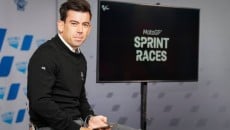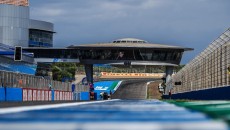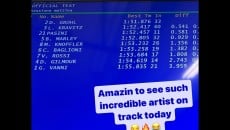MILAN - When Carmelo calls, you have to answer the phone, and GPOne.com was happy to accept the invitation of Dorna's CEO for an interview that - one week before the start of the season - once again demonstrates the serious commitment had by the owners of the MotoGP World Championship. So, in a hotel in Milan, and captured by our cameras, a sort of episode of our famous BAR SPORT took place, with the master of modern motorcycling as our guest. Along with Paolo Scalera (P) and Matteo Aglio (M), Carmelo Ezpeleta (C) answered our questions and doubts before the official start of the 2022 championship on March 6th in Losail.
P: First of all, I want to thank you because, during these two years, you’ve been the “father” of the MotoGP and have led us through a very difficult moment. Remember how, in Qatar, when the MotoGP wasn’t able to race. So, the first question I want to ask you is if you ever feared, at that moment, of having to stop everything.
C: At that moment, no. I always thought about when we couldn't do the MotoGP race, even if the bikes were in Qatar. The problem was with the Italian riders initially, because Italy has a lot of people in the paddock and, without them, we couldn't compete. I was a bit angry because, the Sunday before the race, I thought we could do it. We had thought of sending all the Italians to France and have them take a plane, and everything was almost organized, but we weren’t able to. I was angry, because I thought it was a thing of that moment, then the Minister of Health of Qatar told me: “I think it’s going to be a very serious thing. If I were you, I would go home right away”. At that moment, I was a bit perplexed. Then, once we returned, it all started in Spain too. March 15th to 18th, everything stopped. We had a plan not to do the out-of-home races, but to return to Jerez on the first Sunday in May. That was the only time we worried and said to ourselves: “If it continues like this, and we don't know when it will end, with the number of cases and deaths ...” So we thought about what we would have done if we couldn’t compete in the 2020 races. At that time, we had an online conference with our members, with the Bridgepoint fund and CPPIB, and we said that the paddock had to live on and that, if there were no races performed, we would give the mechanics their salaries. From that moment, when I felt calmer, I started thinking about the various plans for the season, with a plan A, B, and C. Then we made plan A, at the start of the championship in Jerez in July.
P: This year, it’s all starting again in a week in Qatar, and Dorna communicated that it will be a normal GP. Is it all over, or do we still have to be careful?
C: We must always be careful. I don't trust anything. After the Portimão race in 2020, I thought we had made it and, instead, 2021 was almost worse. Not worse, because we knew how things were, but 2021 was difficult. I hope we won’t have any surprises, but I’m prepared to do what is necessary.
M: This will be the longest season ever with 21 GPs. Some say there are too many, but the F1 is already at 23.
C: Yes, but it all comes from the demand we have from new countries to do a GP. This year, we have Finland and Indonesia, and this has led us to make a rotation in the Spanish GP. It’s also true that we finish in November and start in March. It’s a long period without competitions during which we disappear from the world, and that’s not good. We reached an agreement with the constructors and the teams. Until 2026, there will be no more than 22 races. 2021 and 2022 will cost a lot. It’s true that 21 races are a lot compared to the 13 we did in the first year Dorna was in the world championship in 1992. The only thing I can say is that I go to everyone and, if I can do it, I think that the others can too.
M: But where is the MotoGP looking to expand further? United States, South America, Middle eastern countries where, for example. The F1 has many GPs.
C: Asia, mainly because it’s a question of the constructors, and also South America. Obviously, we can’t reduce the number of GPs in Europe. Europe is the heart of motorcycling. I always say that, unlike other famous championships, we and the F1 are a European championship that has managed to do international races that, for example, was not done by American specialties, such as the Indy or Nascar, which have tried to do races outside America and have not succeeded. We and the F1 have a product that is also appreciated out of Europe. And because of all the constructors and interests we have, we must try to go there with an economically feasible budget.
P: Besides Covid, we have another problem this year. Valentino has stopped. Would you have preferred if Valentino had continued with his team – which he has, in fact, but just as a team manager – and see him in all the races, or not?
C: I always prefer to see Valentino because he’s a friend, and I thank him very much for what he did. He’ll come to some races, but I know that his job will continue to be that of competing. He’ll continue with cars. I understand him well, but the team is in good hands, the team is Valentino's.
P: Did it worry you when, at a certain point, it was not clear whether there would be a sponsorship for the team? There was talk of Aramco, then that didn’t happen. Now there’s Mooney that is, however, a large financial group.
C: It didn't bother me. I was in contact with them, and I knew that a team of Valentino’s was certainly there, one way or another.
M: But do you expect a drop in interest now that Valentino is gone? Because we have all seen those yellow stands. The audience he attracted was huge. Do you expect a backlash this year?
C: I expect those people to come anyway and cheer for all the Italians who are Valentino's children.
M: But we recuperated Marquez from the beginning, which is good news. How did you follow that? Because we know that you have a particular bond with all the riders, of course, and he’s been through it all and more in recent years. Did you speak with him when he had an eye problem and didn't know if he could go back to a normal life?
C: I saw he was better with his eye problem than when his arm problem wasn’t getting better. He was less worried. That's my impression. The one of his eye had already happened in the Moto2, and he resolved that well. He told me he had given himself up until Christmas to see if would get better by itself. If not, there was the possibility of surgery, and I said to him: “You’ll see that you won’t need surgery”. And, finally, that’s how it went, not because I said it. I was just trying to cheer him up.
P: You said that you’ll follow the 21-race championship and that the others can do it too, but we’re seeing that decline isn’t in interest but in print media. You’re probably happy with the televisions, but with print? Do you think they follow motorcycling with a passion, with interest?
C: It will depend on how interesting the entertainment, the sport, and the competitions are. We did what we could, creating a system along with the constructors and with the FIM, where we created a system of concessions for motorcycles. I remember when it was Honda and Yamaha who would win all the races. Ducati started, and Ducati was the first to get concessions, because we convinced Honda and Yamaha that it would be interesting for the championship. We have to thank them for this system. They were in a dominant position and were winning, and we told them: “Now a competitor that has more opportunities is entering”, but this proved to be a good thing. Ducati immediately started winning and lost the concessions, then Suzuki lost them, then KTM, and I expect Aprilia to lose them this year. In the tests, there were 20 riders closed in on one second. The championship looks interesting, but the championship is the championship.
P: The F1 is, with Domenicali, somewhat revolutionizing the format with the mini-race on Saturday. Are you happy with the MotoGP format?
C: Yes. I also talked about it with Stefano. He was a revolutionary. We talk a lot. They have certain problems and we have others. I’d like to have a lot of their ‘no problems’ and vice versa. We’re a similar sport, but there are different problems. I always say that cars are important, but circuits are made for motorbikes because the track width allows you to overtake, which is difficult for cars. We have other problems they don't have.
M: Now bikes have wings, spoilers, we’ve seen the Ducati that lowers its rear, in front, even during the lap, and performances are constantly increasing. In your opinion, is it time to put a stop to it? Also for safety purposes.
C: We have an agreement with the constructors – reached with a renewal until 2026 – not to change the technical regulation. Then, if we find something unanimously, or in a large majority, it could be done, but I don’t agree on changing the rules.
P: There are the Spanish, there are the Italians, and now there are also the French. We’re also waiting to have the American riders, like in the past.
C: Especially the British and the Germans.
P: Even the British and Germans. Is there a way to draw them closer? For example, I think you’re very close to Wayne Rainey and his MotoAmerica. The last time I spoke with him, he told me that you guys have been talking.
C: The American Talent Cup begins this year, which is similar to the Road to MotoGP program. The only thing that can be done to find riders is to work, work, work and, unlike before, if we find someone really good, we help him get there, unlike places like Spain or Italy that don't need help.
M: The F1 used the “Drive to Survive” docu-series to enter the American market where it was a bit snubbed. Now there’s going to be a series dedicated to the MotoGP, UNLIMITED. Do you want to follow the same path? What market is still missing?
C: We need to be popular worldwide. Obviously, like I said before, I care a lot about America, I care about the United States. Netflix's F1 series was crucial – according to Silverstone GP organizers – in increasing interest, even though it’s true that they had Hamilton in the lead, and it was the first time the circuit was full. But I think that what we do with Amazon, and I’ve seen the series, will give a vision of the world, which is different from what we were able to show. This openness of the teams, the riders, and the constructors that explain the behind the scenes of the championship seems will be able to help a lot and interest people who aren’t interested.
P: There are six constructors in the world championship, practically only two are missing: Kawasaki and BMW, which are in the SBK. I think, a couple of years ago, you told me that Kawasaki would have liked to race with a CRT type bike. Have there been efforts to get them into the championship?
C: No. I think the ideal championship has six constructors that have the merit of being with us and with six independent teams who have made an effort. The other constructors can enter by reaching an agreement with one of the teams that doesn’t have an agreement now. As a factory, however, there’s no place. They could do something like what Aprilia did up until last year with Gresini.
M: Are you satisfied with the SBK as it is now? Because it seems a bit too similar to the MotoGP with 1000, 4-stroke bikes. Once, when there were 2-strokes, the difference was easier.
C: It's been a long time. I don't know if we still remember the 2-strokes.
M: But isn't now the time to really renew the SBK formula?
C: The SBK is a championship derived from production bikes, so it has a more closed relationship with the constructors and with the model they produce. If the majority asks me to change things, I’ll see what can be done but, for the moment, they are happy to continue like this. I think that, right now, where it’s difficult to have sport bikes for going on road, I’m more for sports people who test them on the circuit. That’s a possibility. They’re very close to the MotoGP, but the difference is that one is superbikes and dedicated to an audience that buys a specific bike, the other is pure prototype, even if the performances are similar. Another difference is that the MotoGP has the best riders historically, and the other has another type of rider, who is certainly very good. But the riders, if they have the choice, are in the the MotoGP.
P: In the past, the five displacements plus the sidecars were almost all at the same level. Angel Nieto, a great champion of small displacements, 50, 80, 125, was absolutely seen as a genius of motorcycling, like Agostini. There were no differences. Today, the interest is all centered on the MotoGP, but you continue to present the three categories.
C: It seems essential to me. It is the heart of the MotoGP, and I think it's all an advantage. We can do three races in one morning, with three starts and three finishes, and the riders, with some of them already seen in the paddock from the Red Bull Rookies Cup. For the line, and to do all this, it seems essential to me to have Moto3, Moto2, and MotoGP, which are stable categories and for which we have a demand for teams to be part of. This is one of the things that motorcyclists must be most proud of: having a championship of three categories, now four with the MotoE.
P: You and I have been following motorcycling for many years. I romantically remember some things that I miss, like the push start. Is there anything that you remember with yearning and that you miss from those times?
C: The age I was when they pushed the bike at the start. The rest is better. I just miss the age I was at that time.








